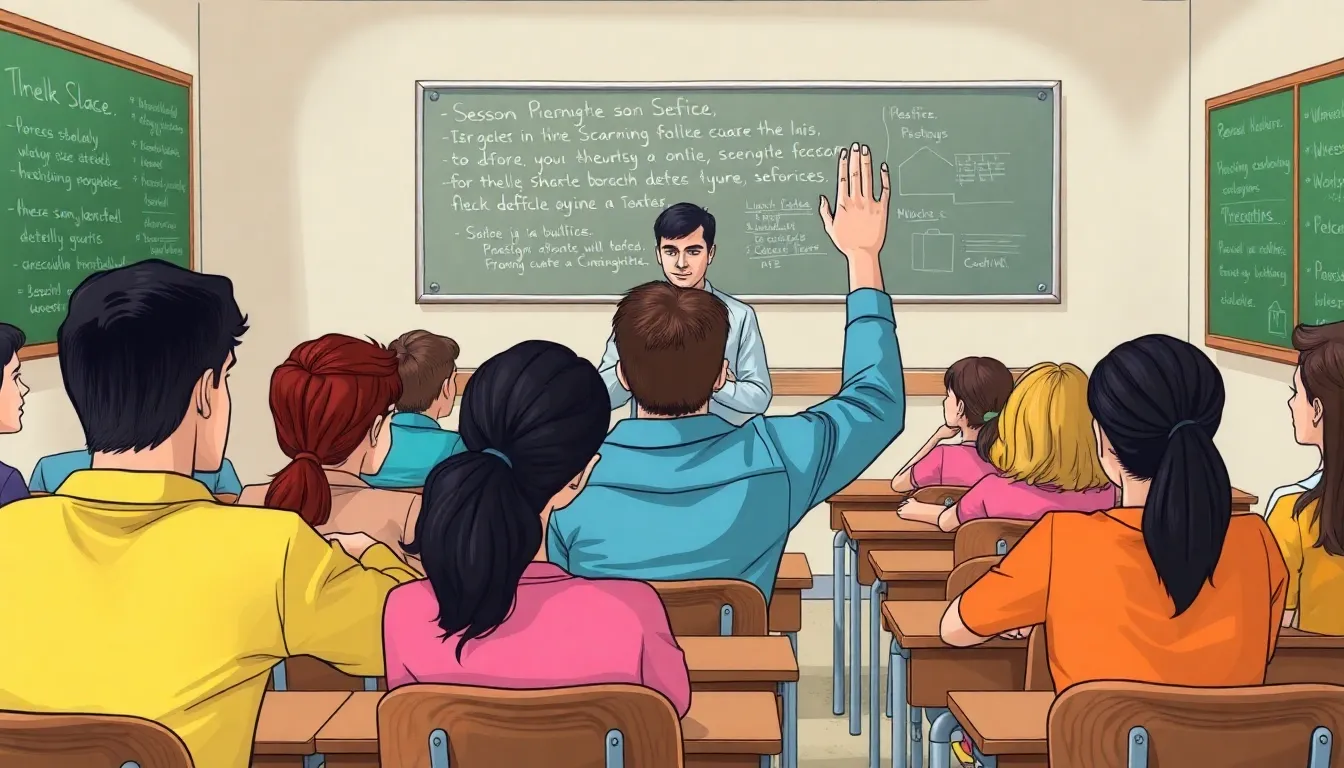Table of Contents
ToggleEducation today resembles a game of musical chairs, where the music stops and students scramble for a seat—only to find there aren’t enough chairs to go around. With rising tuition costs, outdated curricula, and a growing skills gap, it’s no wonder students and parents alike feel like they’re stuck in a never-ending episode of a reality show.
In this chaotic landscape, teachers often juggle multiple roles, from educators to counselors, while trying to keep their sanity intact. The pressure to perform can feel like a high-stakes game of dodgeball, where the balls are standardized tests and the stakes are students’ futures. Understanding these challenges is crucial for anyone invested in shaping a brighter educational landscape. Buckle up as we explore the quirky yet serious problems plaguing education today and what can be done to turn the tide.
Overview of Problems in Education Today
Rising tuition costs create significant barriers for students seeking higher education. Many families struggle to afford college, leading to increased student debt. Outdated curricula fail to align with the current job market, leaving graduates unprepared for the workforce. The skills gap between what employers need and what students offer continues to widen.
Teachers face immense pressures while managing multiple responsibilities. Balancing administrative tasks, lesson planning, and classroom management detracts from their primary role—educating students. Standardized testing often dictates teaching methods, prioritizing test preparation over comprehensive learning. This approach can inhibit creativity and critical thinking among students.
Inequities in funding affect educational quality across different regions. Schools in low-income areas often lack essential resources, resulting in larger class sizes and fewer supplies. Students in these environments face additional challenges, impacting their overall academic performance.
Mental health concerns emerge as students deal with academic stress and social pressures. Anxiety and depression rates among students increase, affecting their ability to concentrate and perform well academically. Schools need to prioritize mental health initiatives and provide support systems for students.
Access to technology creates further disparities in education. Inadequate access to devices and the internet limits students’ opportunities for remote learning. Bridging the digital divide is crucial for equitable educational experiences.
Curriculum relevance also presents obstacles. Many students report a disconnect between what they learn and real-world applications. Enhancing curricula with practical skills and contemporary issues can engage students more effectively.
Overall, these challenges complicate educational outcomes, necessitating strategic reforms and innovative solutions to foster a more equitable and effective education system.
Funding Challenges

Funding challenges create significant barriers in today’s education system. Many schools lack the necessary financial backing to provide quality education.
Insufficient Government Support
Insufficient government support hinders educational progress across various states. Budget cuts often lead to fewer resources, larger class sizes, and limited extracurricular programs. States across the U.S. allocate varying funds to education, contributing to disparities in quality. For instance, some districts receive significantly less funding per student, impacting teacher salaries and student services. Teachers struggle to secure supplies and materials, restricting innovative teaching methods. Consequently, students in underfunded areas experience diminished opportunities compared to peers in wealthier districts.
Inequitable Distribution of Resources
Inequitable distribution of resources exacerbates educational inequality. Schools in affluent areas often enjoy advanced technology and experienced staff. Conversely, institutions in low-income neighborhoods frequently face shortages of basic educational materials. This disparity affects student engagement and learning outcomes. Moreover, adequate funding leads to better facilities, safe environments, and access to extracurricular activities. Research shows that students in well-resourced schools tend to achieve higher academic success. Thus, addressing resource allocation is crucial for fostering a more equitable education system.
Teacher Shortages
Teacher shortages represent a significant challenge in today’s education system. This situation heavily affects student outcomes and overall educational quality.
Causes of Teacher Attrition
Many factors contribute to teacher attrition. Low salaries often fail to reflect the demands of the profession. High stress levels influence teachers’ decisions to leave, as they juggle administrative duties and classroom responsibilities. Limited professional development opportunities discourage career growth, leading teachers to seek positions in other fields. Additionally, lack of support from administrators can make it difficult for teachers to feel valued. These challenges lead to a cycle of turnover, further compounding the shortage and negatively impacting students.
Impact on Student Learning
Student learning suffers as a result of teacher shortages. Increased class sizes create an environment where individualized attention becomes rare. When experienced teachers leave, the influx of less experienced educators can affect classroom management and instructional effectiveness. Students may struggle to grasp concepts in overcrowded settings. Inconsistent teaching also disrupts curriculum continuity, creating knowledge gaps. Consequently, the overall educational experience deteriorates, impacting student engagement and future successes.
Curriculum Gaps
Curriculum gaps represent a significant obstacle in today’s education system. They fail to equip students with skills required in a rapidly evolving workforce.
Lack of Relevance to Modern Skills
Courses often emphasize theoretical knowledge at the expense of practical applications. Most curricula don’t reflect the demands of emerging industries such as technology and healthcare. Graduates encounter difficulties in securing employment due to a lack of applicable skills. Repeatedly, employers express the need for candidates who can adapt, innovate, and collaborate. When education lags behind industry standards, students miss opportunities for meaningful careers.
Limited Focus on Critical Thinking
Traditional education methods prioritize rote memorization over analytical reasoning. Students must navigate complex problems, yet many curricula inadequately teach how to think critically. Educational environments must foster curiosity and creativity. Increasingly, employers value workers equipped with problem-solving skills. The absence of a focus on critical thinking hampers students’ abilities to succeed in real-world situations.
Technology in Education
Technology plays a crucial role in today’s education landscape, yet it brings challenges that impact student learning and access.
Digital Divide
The digital divide presents a significant barrier in education. Many students, particularly those in low-income areas, lack reliable access to technology and the internet. Approximately 15% of households with school-age children do not possess any internet service. Without sufficient access, remote learning opportunities become limited. Schools in affluent areas benefit from advanced tools and platforms, while struggling schools face technology shortages. This inequity forces underprivileged students to miss out on essential resources that enhance their learning experiences. Bridging this gap is vital to ensuring all students receive quality education in a technology-driven world.
Cybersecurity Concerns
Cybersecurity poses additional risks in educational settings. As schools increasingly adopt digital platforms, they become attractive targets for cyberattacks. Data breaches can expose sensitive information, including student records and staff details. About 37% of educational institutions reported experiencing cyberattacks recently. Protecting against these threats requires robust cybersecurity measures and continuous staff training. Vulnerabilities in networks can disrupt learning environments and compromise student safety. Ensuring secure online practices is essential for protecting educational stakeholders and maintaining trust in technology-based learning.
Mental Health Issues Among Students
Mental health issues among students significantly impact their well-being and educational success. Research indicates that high levels of stress and anxiety contribute to declining mental health in educational settings.
Stigma Around Seeking Help
Stigma often prevents students from seeking mental health assistance. Fear of judgment creates reluctance to discuss struggles with peers or adults. Many students experience isolation because of this stigma. Educational institutions play a critical role in fostering an environment where seeking help is normalized. Increasing awareness campaigns can help diminish the negative perceptions surrounding mental health. Schools that prioritize mental health education contribute to destigmatization efforts, encouraging students to reach out when necessary.
Impact on Academic Performance
Mental health struggles directly affect academic performance. Anxiety, depression, and stress can limit students’ ability to concentrate and engage in learning. Studies show that students with mental health challenges experience lower grades and higher dropout rates. Disengagement from school often stems from untreated mental health issues. Providing adequate support services can improve academic outcomes. Schools that implement mental health resources witness increased student performance and retention. Addressing these issues is essential for creating a more supportive educational atmosphere.
Addressing the myriad challenges in today’s education system is crucial for fostering a more equitable and effective learning environment. Rising tuition costs and outdated curricula create barriers that hinder students’ success and limit access to opportunities.
Moreover the impact of mental health issues and the digital divide further complicate the landscape. Schools must prioritize comprehensive support systems and modernize their approaches to meet the needs of all students.
By acknowledging these obstacles and implementing strategic reforms educational stakeholders can pave the way for a brighter future where every student has the chance to thrive.







